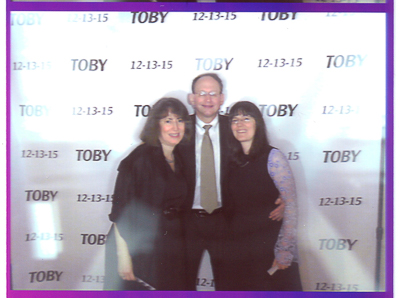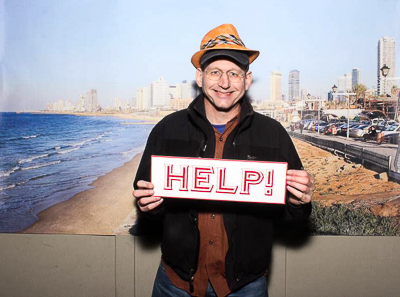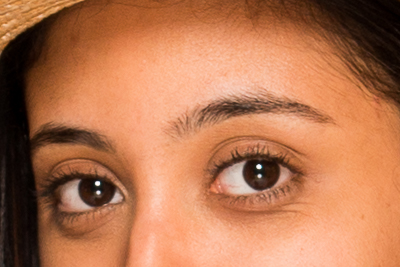Photo Booths vs. Photo Studios
(The case for quality)
Copyright 2016 by Michael Brochstein
|
|
Photo Booths vs. Photo Studios Copyright 2016 by Michael Brochstein |
|
(See below
for issues regarding
Step & Repeats) The idea for this article came from two separate parts of my life. In one part of my life I have been a guest at various events which had photo booths. The resulting images have usually been amusing and typically worthy of posting on Facebook. Before I tell you about the other part of my life that sparked the idea for this article, let me show you the results of two visits to a photo booth at an event in late 2015. At this photo booth guests received a printed strip of three photos. I went to the photo booth twice and the images below were the best of the (six) images that resulted. It was this (poor) experience that led me to start thinking about writing this article. |
||
 |
 |
|
| As you may have guessed, the guy in above photos above is me. It would be misleading and quite inaccurate for me to infer that a typical photo booth produces such poor quality imagery. I feel sorry for the the sponsor of the event as the quality of the photo booth was so much worse than what is available with a properly set-up and run photo booth. In fact, just a few months prior I was at an event with a different photo booth and obtained the following images. | ||
 |
 |
|
|
As you can see, these images are much sharper and are quite acceptable
in quality for images from a photo booth. In another part of my life I am a professional photographer (see www.FluentImagery.com) who creates on-location photo studios for client's portraits and headshots as well as for photo booth type operation. Before I tell you how these on-location studio's differ from that of a typical photo booth, let me show you typical results from an on-location professional photo studio (in this case, one that operated as a photo booth). |
||
 |
 |
|
| The image on the right is a small section of the image on the left (the eyes of the woman in the middle). | ||
|
Photo booths are not all identical but they all have a camera (and
lens), lights, printer and a computer to control the usually automated
operation the booth. Many booths also have a way to enter an email
address so that the images can be emailed to the users of the booth.
More elaborate booths might also have green screens which allow
different backgrounds to be inserted into the images after they are
taken (i.e. do you want it to appear that you are standing on the moon
instead of in a photo booth) as well as social media and online gallery
options etc. Vendors may also offer props and other customization
options. There are a few main differences between a typical photo booth's equipment and an on-location photo studio's setup. |
||
| 1. Camera - A typical photo booth uses cameras that
vary from a typical "point & shoot" to a consumer level DSLR. An
on-location photo studio might use a professional grade (full frame?)
DSLR camera. 2. Lens - A typical photo booth camera uses either the lens permanently affixed to the camera or a low end "kit lens" if it is a DSLR. An on-location photo studio might use a professional grade DSLR lens. 3. Lighting - Some photo booths have a large box on a stand that contains the camera and lights and others have lights that are separate. Photo studios have distinct lights on separate light stands. 4. Complexity of setup and operation - Whereas a photo booth might integrate a lot of its components into a very few pieces of equipment, an on-location photo studio keeps them all separate. |
| All this would be moot if a photo booth cost a small fraction of what an on-location photo studio might cost. In that case one would pay much less and expect much less. Below are some typical costs for a photo booth (as of February 2016). They include many options besides just a strip of printed photos for each photo booth user. |
| Vendor Name | Cost | Comments |
| Hipster | $1,294 | Full featured, up to 6 hours, with attendant, NY, NJ, CT, PA+ |
| Mashbooths | $1,294+ | Full featured, price is for 4 hours, with attendant, NY, NJ, CA,+ |
| An on-site no frills photo studio will generally take up much more space than a photo booth. If its only purpose is to allow guests to pose by themself or with ad-hoc groups then only one photographer is needed to operate the studio. On-site printing of images, green screen background substitution and other options will require a second person, a "digital technician", to operate a computer where the images will be edited and to control the printing as well as any online (email, photo galleries, social media) activities that are required. The use of a second person allows the photographer to continually take photos and maximizes the use of the photo studio. Without the use of a digital technician, all printing, online gallery posting and other tasks would need to be performed after the event is over so as to allow the photographer to concentrate on taking new images at the event. |
| Choices! |
|
Is the reason for setting up a photo booth (or a Step & Repeat) the more immediate
gratification of your guests as well as for social media? Is it long
term with a preference for high quality and properly lit images that can
be printed in large sizes and displayed on a wall? Is it for both? There is no one right answer for everyone. There is only the answer that is best for you. |
|
Step & Repeat Issues (Also applies to some Photo Booths) |
|
It is common these days for there to be a large (8' x 8' or larger)
banner hanging at events for guests to pose in front of. These banners
typically have a logo and/or name of the event printed many
times on it. Event organizers hope that guests will pose for photos in front of these banners not just for a personal pictorial keepsakes but also for posting on social media as well as for use as publicity by the event organizers. Most Step & Repeat banners are printed on vinyl. Vinyl is economical and long lasting as well as a very reflective surface. The reflection of a camera's flash can result in distracting and unattractive white spots in the middle of images as vinyl's surface can act as a mirror for a flash. A major difference between the use of a typical vinyl Step & Repeat banner and a professional quality photographic background (and it's attending lighting setup) is that unintended reflections are minimized by design. The materials used for professional photographic backgrounds are generally nowhere near as reflective as a vinyl banner can be and lighting setups used by photographers are carefully designed to avoid unwanted reflections. |
| Feedback / Questions: Please feel free to email Michael Brochstein with any comments, suggestions and/or questions. | |
| Full Disclosure: This is to let you know that the author has no financial interest in any of the items, vendors or websites mentioned on this page. | |
Last update: 2/3/16